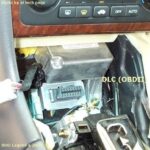Navigating the complexities of modern vehicle diagnostics often begins with understanding your truck’s OBD2 connector. This port is your gateway to accessing a wealth of data from your vehicle’s computer system, enabling you to diagnose issues, monitor performance, and even perform modifications. For truck owners, especially those looking to delve into DIY diagnostics or modifications, understanding the OBD2 connector and associated tools like bypass cables and diagnostic software is crucial.
For certain trucks, accessing the OBD2 port for modifications or advanced diagnostics may require a bypass cable. The standard OBD2 port, typically located under the dashboard, might be disabled when using certain diagnostic tools. A bypass cable effectively reroutes the connection, allowing access for scanners and software. There are generally two types of bypass cables available. One type, often more budget-friendly and found on platforms like Amazon, requires a manual connection which some users jokingly refer to as “truck yoga” due to the potentially awkward positioning required for installation. Critically, this type usually disables the factory OBD port while in use, meaning you must use the OBD port on the bypass cable itself. Before visiting a dealership or repair shop, it’s essential to remove this cable to restore the standard OBD port functionality for their diagnostic equipment.
The second type of bypass cable offers a more seamless experience. According to user reports, this type can remain permanently installed, leaving the original OBD port fully functional even when the bypass is in place. While the specific brand name of this cable isn’t mentioned in the original post, further research online can easily reveal available options.
Once you have established a reliable OBD2 connection, the next step is choosing the right diagnostic tools. Standard code readers may have limited functionality. For in-depth diagnostics and modifications, software like AlfaOBD is highly recommended by experienced users. It’s important to note that AlfaOBD primarily operates on Android devices (smartphones and tablets), although a Windows version requiring a specific interface cable is also available. The investment in AlfaOBD, around $50, is often considered worthwhile for the level of access and control it provides over vehicle modules.
For a robust scanning experience, consider investing in a high-quality OBD2 scanner like the OBDLink MX+. This scanner is praised for its ability to read all the necessary modules for comprehensive diagnostics and modifications. While such equipment can represent a significant upfront cost, especially when considering software and bypass cables, many users find it to be a worthwhile investment in the long run. Purchasing tools during sales events like “Black Friday” can help reduce costs. The philosophy of “buying the best tools you can afford” often proves true in automotive diagnostics, saving both time and money compared to dealership visits for simple programming changes or troubleshooting.
However, it’s critical to approach OBD2 modifications with caution. These systems are powerful and allow for significant changes to your vehicle’s programming. Before making any modifications, it is strongly advised to thoroughly research and understand the potential consequences. Consulting online forums dedicated to AlfaOBD and watching instructional videos on platforms like YouTube are excellent ways to gain knowledge and make informed decisions about equipment purchases and modifications. Crucially, always create system backups before making any changes and proceed incrementally, making only one change at a time. Verifying that you can successfully restore from your backups is a vital safety step before proceeding with further modifications. By taking a cautious, informed approach, you can safely leverage the power of Obd2 Connectors and diagnostic tools to enhance your truck ownership experience.
